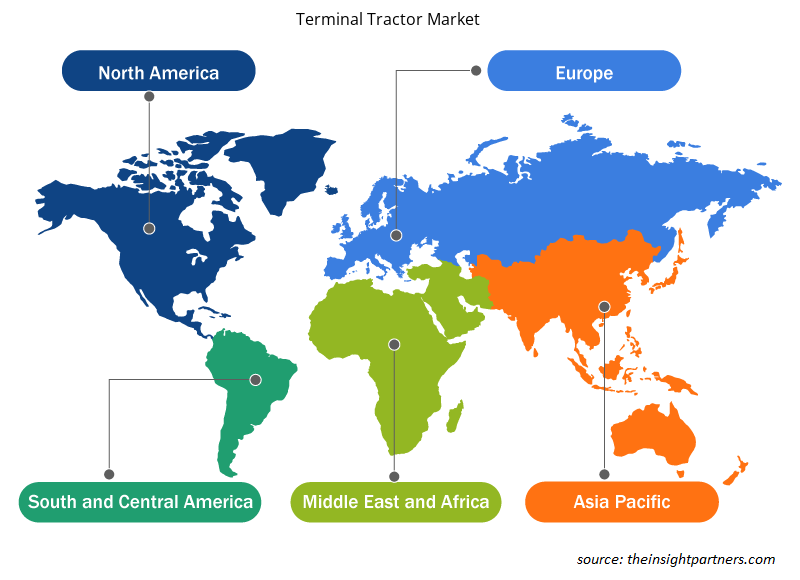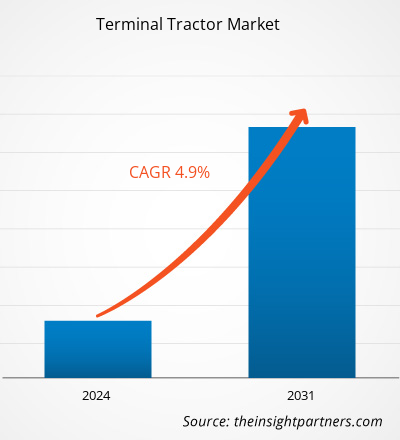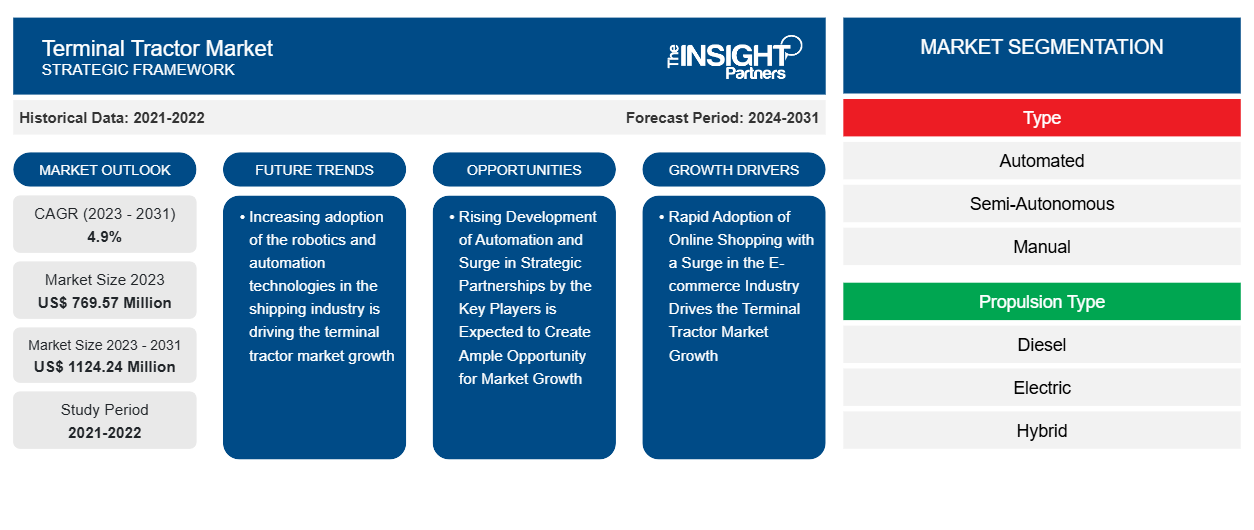터미널 트랙터 시장 규모는 2023년 7억 6,957만 달러에서 2031년까지 1,124.24만 달러에 도달할 것으로 예상됩니다. 이 시장은 2023~2031년에 4.9%의 CAGR을 기록할 것으로 예상됩니다. 터미널 트랙터 시장은 전자상거래 산업의 증가하는 상품 운송 수요에 의해 주도됩니다. 또한 선박, 터미널, 항구 및 지역 유통 센터에서 화물 처리 솔루션에 대한 수요 급증은 터미널 트랙터 시장 성장을 이끄는 주요 요인입니다. 이러한 트랙터는 높은 신뢰성과 더 높은 운송 용량을 제공하며 부피가 큰 상품을 효율적으로 운송할 수 있습니다. 유엔 무역 개발 회의(UNCTAD)에 따르면 2021년에 전 세계 항구에서 8억 4,950만 개 이상의 20피트 동등 컨테이너가 이동했습니다.
터미널 트랙터 시장 분석
터미널 트랙터 제조업체는 글로벌 터미널 트랙터 시장에서 경쟁력을 유지하기 위해 신제품을 개발하고 여러 제품을 출시하는 데 중점을 둡니다. 터미널 트랙터 시장 제조업체는 적용 범위를 개선하기 위해 제품에 고급 기능과 고급 기능을 도입하는 데 중점을 두고 있습니다. 터미널 트랙터 제조업체가 전 세계적으로 시장 입지를 확대하는 데 도움이 되는 합병, 파트너십, 협업 및 인수가 증가함에 따라 시장 성장에 대한 충분한 기회가 창출되고 있습니다. 터미널 트랙터 회사는 물류, 창고 운영자, 운송 회사 및 무역 회사와 파트너십을 맺어 운송 시설을 확보하여 장기적으로 수익을 늘립니다.
터미널 트랙터 시장 개요
전 세계의 물류 서비스 제공업체는 터미널 트랙터를 널리 사용합니다. 전자 상거래 산업이 급속도로 등장하면서 증가하는 물류 부문은 예측 기간 동안 터미널 트랙터 시장 성장을 이끄는 주요 요인입니다. 터미널 트랙터는 세미 트레일러, 적재 및 빈 운송 컨테이너를 짧은 거리로 효율적이고 빠르게 운송하는 데 사용되는 8등급 산업용 차량입니다. 일반적으로 창고, 운송 항구, 화물, 트럭 터미널 및 크로스도크 시설에서 운영되며 오프로드 및 온로드 애플리케이션에 맞게 구성됩니다. 야드 트럭, 야드 조키, 스포터 트럭, 야드 호스텔러 및 션트 트럭과 같은 다양한 이름으로 알려져 있습니다. 이 트랙터의 특징으로는 운전자의 가시성이 향상된 단일 캡 오프셋, 회전 반경을 위한 짧은 휠베이스 및 운전자를 위한 슬라이딩 도어가 있습니다.
귀하의 요구 사항에 맞게 이 보고서를 사용자 정의하세요
이 보고서의 일부 또는 국가 수준 분석, Excel 데이터 팩을 포함하여 모든 보고서에 대한 사용자 정의를 무료로 받을 수 있으며 신생 기업 및 대학을 위한 훌륭한 혜택과 할인 혜택을 이용할 수 있습니다.
-
이 보고서의 주요 시장 동향을 알아보세요.이 무료 샘플에는 시장 동향부터 추정 및 예측까지 다양한 데이터 분석이 포함됩니다.
터미널 트랙터 시장 동인 및 기회
전자상거래 산업의 급증과 함께 온라인 쇼핑의 급속한 채택이 터미널 트랙터 시장 성장을 촉진합니다.
급속도로 성장하는 전자상거래 산업은 소포 배달 및 최종 사용자를 관리하기 위한 글로벌 터미널 트랙터에 대한 엄청난 수요를 만들어냈습니다. 온라인 쇼핑에 대한 수요 증가와 전 세계 인터넷 보급의 급속한 성장은 터미널 트랙터 시장 성장을 이끄는 주요 요인입니다. 2023년에 1조 1,200억 달러에 달하는 미국의 전자상거래 부문 매출은 2022년 1조 300억 달러에 비해 약 7.6% 증가했습니다. 한편, 전 세계 전자상거래 매출은 2023년에 5조 800억 달러에 달했으며 2022년 대비 3.8% 증가했습니다. 전 세계적으로 전자상거래 부문이 급증하면서 온라인 쇼핑이 빠르게 도입되면서 예측 기간 동안 터미널 트랙터 시장이 성장했습니다.
전자상거래 산업의 급속한 확장으로 소포 및 상품 운송을 위한 터미널 트랙터에 대한 수요도 증가했습니다. 터미널 트랙터 시장 성장을 주도하는 주요 부문에는 해양, 제약, 소매, 식품 및 음료가 포함됩니다. 게다가 터미널 트랙터 시장 성장은 빠르게 움직이는 소비재의 급증으로 인해 예측 기간 동안 터미널 트랙터 시장 성장이 촉진됩니다.
자동화 개발의 증가와 주요 업체의 전략적 파트너십 급증은 시장 성장을 위한 충분한 기회를 창출할 것으로 예상됩니다.
터미널 트랙터 시장의 주요 업체는 소비자의 수요를 충족하기 위해 전략적 파트너십을 맺습니다. 예를 들어, 2022년 8월, Cargotec의 사업부인 Kalmar는 Maldives Ports Ltd.와 파트너십을 맺어 T2i에 터미널 트랙터 3대를 제공했습니다. 구매는 Cargotec의 인테이크에서 이루어졌으며 2023년 1분기에 인도되었습니다.
- 2022년 7월, 칼마는 헬싱보리 포츠 유한회사와 협력하여 칼마 전기 트랙터 터미널 리치스태커를 제공했습니다. 이 계약에는 트랙터 터미널 채택, 장비 운영자 및 유지 관리 요구 사항에 대한 교육이 포함됩니다.
- 2022년 6월, Terberg는 완전 자동화된 전기 트랙터를 출시했습니다. 혼합 교통을 위해 설계된 자율 주행 설계입니다. 효율적이고 안전한 자율 주행 운송입니다.
- 2022년 1월, 칼마는 Coast Autonomous Inc.와 협력하여 고급 칼마 로봇 포트폴리오를 출시했습니다. 이 제품은 화물 운송 및 자재 취급 생산성을 높이기 위한 지능형 모바일 장비 솔루션으로 구성되어 있습니다.
터미널 트랙터 시장 보고서 세분화 분석
터미널 트랙터 시장 분석에 기여한 주요 세그먼트는 유형, 플랫폼, 응용 프로그램 및 최종 사용자입니다.
- 유형별로 보면 시장은 자동, 반자동, 수동으로 나뉜다. 이 중 수동이 2023년에 가장 큰 점유율을 차지할 것으로 보이는데, 이는 물류 및 유통 부문 전체에서 수요가 빠르게 증가했기 때문이다.
- 추진 유형에 따라 시장은 디젤 , 전기, 하이브리드, CNG로 나뉩니다. 이 중 CNG는 더 높은 효율성과 물류 부문의 수요 증가로 인해 빠른 속도로 성장하고 있습니다.
- 응용 프로그램을 기준으로 터미널 트랙터 시장은 물류, 물류 및 유통, 공항, 컨테이너 터미널 등으로 구분됩니다. 이 중 물류 및 유통 부문이 2023년에 가장 큰 점유율을 차지합니다.
지역별 터미널 트랙터 시장 점유율 분석
터미널 트랙터 시장 보고서의 지리적 범위는 주로 북미, 유럽, 아시아 태평양, 중동 및 아프리카, 남미의 5개 지역으로 나뉩니다.
북미는 2023년에 가장 큰 점유율을 차지할 것으로 예상되며, 미국은 예측 기간 동안 빠른 속도로 성장하고 있습니다. 이러한 성장은 Kalmar, Inc., REV Group Inc., Terberg, Mol과 같은 주요 제조업체의 존재 때문입니다. 또한 이 지역의 물류 및 창고 부문에서 최신 기술 도입이 급증함에 따라 투자가 증가하면서 터미널 트랙터 시장 성장이 촉진되고 있습니다.
아시아 태평양 지역은 예측 기간 동안 중국 기업이 중국에서 컨테이너를 운송하는 데 있어 지배력이 커지면서 가장 높은 CAGR로 성장하고 있습니다. 또한, 전자상거래 부문의 성장, 세계화의 출현, 산업 4.0의 진화, 아시아 태평양 지역의 개발도상국에서 스마트 팩토리의 도입이 예측 기간 동안 터미널 트랙터 시장 성장을 주도하고 있습니다.
또한, 이탈리아, 프랑스, 독일, 영국 등 주요 국가에서 터미널 트랙터 제품에 대한 수요가 있기 때문에 유럽도 예측 기간 동안 상당한 속도로 성장하고 있습니다.
터미널 트랙터 시장 지역 통찰력
Insight Partners의 분석가들은 예측 기간 동안 터미널 트랙터 시장에 영향을 미치는 지역적 추세와 요인을 철저히 설명했습니다. 이 섹션에서는 북미, 유럽, 아시아 태평양, 중동 및 아프리카, 남미 및 중미의 터미널 트랙터 시장 세그먼트와 지리에 대해서도 설명합니다.

- 터미널 트랙터 시장에 대한 지역별 데이터 얻기
터미널 트랙터 시장 보고서 범위
| 보고서 속성 | 세부 |
|---|---|
| 2023년 시장 규모 | 7억 6,957만 달러 |
| 2031년까지 시장 규모 | 11억 2,424만 달러 |
| 글로벌 CAGR (2023-2031) | 4.9% |
| 역사적 데이터 | 2021-2022 |
| 예측 기간 | 2024-2031 |
| 다루는 세그먼트 |
유형별로
|
| 포함된 지역 및 국가 |
북아메리카
|
| 시장 선도 기업 및 주요 회사 프로필 |
|
터미널 트랙터 시장 플레이어 밀도: 비즈니스 역학에 미치는 영향 이해
터미널 트랙터 시장 시장은 소비자 선호도의 변화, 기술 발전, 제품의 이점에 대한 인식 증가와 같은 요인으로 인해 최종 사용자 수요가 증가함에 따라 빠르게 성장하고 있습니다. 수요가 증가함에 따라 기업은 제품을 확장하고, 소비자의 요구를 충족하기 위해 혁신하고, 새로운 트렌드를 활용하여 시장 성장을 더욱 촉진하고 있습니다.
시장 참여자 밀도는 특정 시장이나 산업 내에서 운영되는 회사나 기업의 분포를 말합니다. 주어진 시장 공간에 얼마나 많은 경쟁자(시장 참여자)가 존재하는지 그 규모나 총 시장 가치에 비해 나타냅니다.
터미널 트랙터 시장에서 운영되는 주요 회사는 다음과 같습니다.
- 칼마 주식회사
- 코네크레인스 오이제이
- 삼이그룹
- 테르버그 그룹 BV
- 하이스터-예일 머티리얼 핸들링 주식회사
- MAFI 운송 시스템 GmbH
면책 조항 : 위에 나열된 회사는 어떤 특별한 순서에 따라 순위가 매겨지지 않았습니다.

- 터미널 트랙터 시장의 주요 기업 개요를 알아보세요
터미널 트랙터 시장 뉴스 및 최근 개발
터미널 트랙터 시장은 1차 및 2차 조사 이후의 정성적, 정량적 데이터를 수집하여 평가합니다. 여기에는 중요한 기업 간행물, 협회 데이터 및 데이터베이스가 포함됩니다. 다음은 터미널 트랙터 시장과 전략에 대한 시장의 개발 목록입니다.
- 2022년 8월, Cargotec의 일부인 Kalmar는 Maldives Port Limited에서 T2i 터미널 트랙터 3대에 대한 공급 계약을 체결했습니다. 주문은 2023년 1분기까지 배송될 예정입니다. (출처: DJI, 보도자료/회사 웹사이트/뉴스레터)
- 2022년 6월, 코트디부아르 터미널은 Gaussin이 공급한 14대의 새로운 APM 75T HE 전기 터미널 트랙터를 아비장 항구의 운송 서비스에 사용하기 위해 인도한다고 발표했습니다. 그러나 주문은 터미널 트랙터 36대를 위한 것이었으며, 2022년 4분기까지 단계적으로 공급되었습니다. (출처: DJI, 보도자료/회사 웹사이트/뉴스레터)
터미널 트랙터 시장 보고서 범위 및 제공물
"터미널 트랙터 시장 규모 및 예측(2021-2031)" 보고서는 아래 영역을 포괄하는 시장에 대한 자세한 분석을 제공합니다.
- 범위에 포함된 모든 주요 시장 세그먼트에 대한 글로벌, 지역 및 국가 수준의 시장 규모 및 예측
- 동인, 제약 및 주요 기회와 같은 시장 역학
- 주요 미래 트렌드
- 자세한 PEST 분석
- 주요 시장 동향, 주요 업체, 규정 및 최근 시장 동향을 포괄하는 글로벌 및 지역 시장 분석
- 시장 집중도, 히트맵 분석, 유명 기업 및 최근 개발 사항을 포함하는 산업 환경 및 경쟁 분석
- SWOT 분석을 통한 자세한 회사 프로필
- 과거 분석(2년), 기준 연도, CAGR을 포함한 예측(7년)
- PEST 및 SWOT 분석
- 시장 규모 가치/거래량 - 글로벌, 지역, 국가
- 산업 및 경쟁 환경
- Excel 데이터세트
최근 보고서
사용 후기
구매 이유
- 정보에 기반한 의사 결정
- 시장 역학 이해
- 경쟁 분석
- 고객 인사이트
- 시장 예측
- 위험 완화
- 전략 기획
- 투자 타당성 분석
- 신흥 시장 파악
- 마케팅 전략 강화
- 운영 효율성 향상
- 규제 동향에 발맞춰 대응























 무료 샘플 받기 - 터미널 트랙터 시장
무료 샘플 받기 - 터미널 트랙터 시장